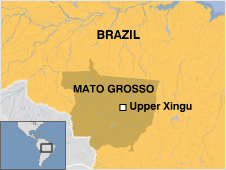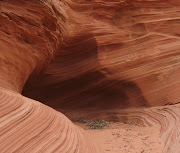
Simultaneously, I am excited and kind of horrified. The Amazon rainforest already disappearing at aAnd no one has found lost cities in the Amazon forests. Twentieth-century anthropologists concluded there weren't any, believing that "urbanism" in pre-Columbian South America existed only in
the A
ndes Mountains.
Scientists working in Brazil say hold on — they've found the remnants of several clusters of towns built as long as seven centuries ago.
Michael Heckenberger from the University of Florida has been excavating in a region of the southern Amazon called Xingu.
"The real kind of head-ringer," he says, "is the fact [the villages] never occur alone."
 horrible clip to raise cattle and farms
horrible clip to raise cattle and farms and build roads through the rainforest for biofuels is creating havoc with nature, the Earth's collong system and sustainability. More people will want to study the area's findings, meaning more degradation of the environment that the planet can ill afford. MatoGrosso has already lost half its trees as seen by satellite images. Pre-columbian finds in the upper Xingu River, a tributary that feed into the Amazon, are establishing a pattern of sophistication and organization that were not credited to the area until the rise of the Incas.
and build roads through the rainforest for biofuels is creating havoc with nature, the Earth's collong system and sustainability. More people will want to study the area's findings, meaning more degradation of the environment that the planet can ill afford. MatoGrosso has already lost half its trees as seen by satellite images. Pre-columbian finds in the upper Xingu River, a tributary that feed into the Amazon, are establishing a pattern of sophistication and organization that were not credited to the area until the rise of the Incas."They have quite remarkable planning and self-organisation, more so than many classical examples of what people would call urbanism," he said.
Although the remains
are almost invisible, they can be identified by members of the Kuikuro tribe, who are thought to be direct descendents of the people who built the towns.
The tell-tale traces included "dark earth" that indicated past human waste dumps or farming, and concentrations of pottery shards and earthworks.
The researchers also made use of satellite images and GPS navigation to uncover and map the settlements over the course of a decade.
The communities consisted of clusters of 60-hectare (150-acre) towns and smaller villages spread out over the rainforest.South America is becoming a bigger hotbed of archaeological finds supporting a quality of life better than historians estimated. More old myths of European superiority are crashing everywhere as the elimination of the tribes is thought to have happened with Europe's colonization efforts and the range of diseases they brought with them. The Brazilian anthropologists and a local member of the indigenous people had their proof of concept paper published in Science. Those who won the battles wrote the first histories and now the truth is starting to emerge more fully right before our modern urban eyes.

A true view and flavor of the Amazon's ecology and indigenous peoples can be found in Bruce M. Beehler's contemporary Lost World: Adventures in the Tropical Rainforest for less than $20US. It takes you to the rainforest without all of the bug repellent and gives the supreme rationales of conserving an area vital to the health and well being of 6,000,000,000 folks on our shared planet.










1 comment:
We see again the difference between societies with writing and those with only oral tradition. Just as our own oral past is gone, the Aristotles, Euclids, Lao-Tsu's,
etc. are gone from the ancient sociaties of Amazonia, unable to leave their wisdom behind, but for a tiny percent puzzle of physical changes they made. We don't know why or how, just what.
thanks--ml
melertz@hotmail.com
Post a Comment